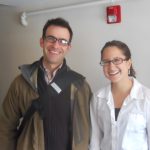
Hanna Saltzman, Williams class of 2012, spoke of the spiritual dimensions of local food to a fascinated log lunch crowd on April 27th. Hanna’s yearlong thesis explores the assumption that local food is healthy food: “People believe it to such an extent that they take it as common sense.” There are 4 different ways people connect health, food, and locality.
- Bodily health: organic pesticide-free vegetables are less likely to cause various diseases
- Environmental health: small-scale agriculture is less environmentally degrading than conventional agriculture
- Political health: Money used to grow and buy local food stays within local economies, and the interaction between farmer and consumer creates social relationships
- Spiritual health: local agriculture creates a spiritual connection, both individually and culturally, with food
It was this fourth aspect of health that Hanna focused on in this discussion. She cited two points from Joel Salatin’s speech this February: the idea that soil is a live and that nature is everywhere. Hanna pointed out that objects that we normally assign as passive are becoming active in the local food movement. Things that we do not normally consider alive have been given an agency, an active power. Hanna chose to expand on two concepts from her thesis to explore this power.
Hanna noted from her interviews that most local farmers voiced desires for it to be easier to slaughter on site. This desire twinned with the collectively agreed upon ethic that it is good/necessary for people who eat meat to perform slaughter. Hanna described this act as a “ritual” that must be visible, intimate, and involve self-reflection. The meat is transformed into an object that affects one’s consciousness. The slaughterers are transformed into ethical, conscious beings.
During her interviews, Hanna began to realize that the word “fresh” was a signifier of broader social relationships among food, health, and locality. Using raw milk as a case study, Hanna realized she couldn’t separate its physical and symbolic properties. “Fresh” indicated medicinal, political, and deep health. Drinking raw milk, which is unpasteurized, meaning filled with microbes, is an act of ingesting life, “a way to get closer to life.” “Fresh” began to mean “pure.”
Hanna concluded by considering the criticism that holistic health is elite or impractical. Though she agreed that this criticism may be apt at times, she also argued that holistic health and spirituality cannot be written off: “Can people feel invested in sustainability if it doesn’t offer some personal satisfaction, pleasure, or happiness? If we don’t take seriously psychology and spiritual needs, can we have an active policy?”
Written by Claire Lafave ’12, CES Research Assitant